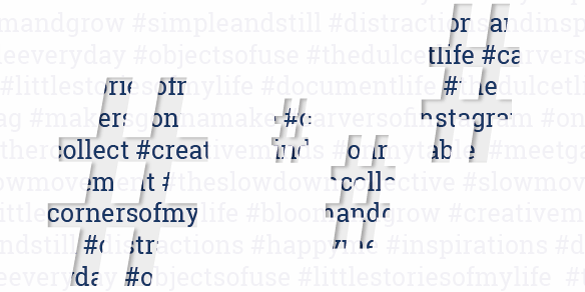
Octothorpe – the many lives of one sort
Friday 24 November 2017
Today the octothorpe is best known for its use in hashtags on social media.

Friday 24 November 2017
Today the octothorpe is best known for its use in hashtags on social media.
It is not uncommon to find typographic terminology which has transferred from its origins in letterpress printing to the world of desktop publishing. But sometimes a specific sort or glyph makes the transition from one use to another – you could say repurposed for the modern age.
Today the octothorpe is most commonly known as the ‘hash sign’ used for creating searchable hashtags on social media. The latest development has even seen the hashtag moving beyond social media and into speech – ‘hashtag irritating habit’. But these newest of uses of the now ubiquitous symbol represent just one of many unrelated ways in which the octothorpe has been used – and just one of its many names.
Known variously as an octothorpe, hash, numeral sign, pound, hex, flash, grid, tic-tac-toe, pig pen, or square, during its lifetime the symbol has been used in ways as diverse as the notation of checkmate in chess, an insertion in proofreading, to indicate a comment in computer code, as a function button on touchtone phones, to identify a colour in HTML, a village in cartography and, in America, to denote weight.
According to Keith Houston in his book, Shady Characters, this last application is the key to the origins of this ‘frustratingly slippery beast’.
For what feels like such a modern symbol (GQ Magazine awarded it a slightly tongue in cheek ‘Symbol of the Year’ in 2010), it has surprising ancient origins. In ancient Rome, the word for pound (in weight) was ‘libre’. This was abbreviated to lb, which is still in use today. However, at the time it was customary to indicate this abbreviation by crossing the ascenders with a tilde. The resulting shape is very similar in appearance to the octothorpe, and Houston attributes the remaining changes to the ‘carelessly rushing pens of successive scribes’.
But why wasn’t this the end of the story? Why was the same symbol reused in so many different ways? Today the variety of characters we have access to via our computer keyboards feels endless. In fact, it is shaped by something called the ASCII (American Standard Code for Information Interchange) whose standard extended character set now offers 256 characters, 224 of which are generally available through desktop publishing software*. It wasn’t always this way, however. The 94 characters offered by the original ASCII, together with the desktop publishing software of the time (the typewriter) may go a long way towards explaining why the octothorpe needed to be repurposed.
During the 1960s when Bell Telephone Laboratories were developing the touch-tone telephone system, they decided to use the octothorpe as one of the two function buttons on the keypad. The reasons Houston cites for this choice are that the symbol appears in the ASCII and on standard typewriter keyboards and that this would make it easy for the system to be documented.
The typographic symbols and characters that we use every day all have interesting stories behind them. Some are firmly rooted in fact, some are serious scholarly theories, and some are delicious but questionable. The stories about how the octothorpe got its name do not disappoint.
Houston‘s Shady Characters documents multiple possible origins of the name. Having dismissed the origin cited by Robert Bringhurst in his book ‘The Elements of Typographic style’ – which states that the origin of the name is from its use as a cartographic symbol denoting a village (thorpe) surrounded by eight (octo) fields – as ‘charming, but flawed’, Houston returns to Bell Telephone Laboratories as the most likely origin of the name.
With the hash sign selected as a function button for the touchtone telephone, the engineers then needed to give it a standard name in order to be able to refer to it in their documentation and training. With no definitive name in existence, they made one up.
The ‘octo’ part seems fairly obvious, but according to Houston, the ‘thorpe’ or ‘therpe’ could either come from a mischievous desire to include a ‘th’ diphthong in order to make the word hard for Germans to pronounce; or be a show of support for the return of confiscated Olympic medals to the deceased American athlete, Jim Thorpe. Both explanations seem as peculiar as each other.
To find out more about the history of the octothorpe – and nine other typographic symbols – read Keith Houston’s book Shady Characters, or visit him online.
* It’s interesting to note that Apple doesn’t feature the octothorpe on their computer keyboards. Typing a hash on a Mac requires the use of a function key. With the explosion of the hashtag on social media, it will be interesting to see if this is something that Apple revisit in the future.
Recent posts
Featured posts

Hello! I’m Sarah, an independent typographic designer, helping businesses to communicate their unique selling points through printed marketing and communications.
I’ve been sharing my knowledge about design, typography, marketing, branding and printing since 2014. I hope you enjoy reading my blog.

Sarah Cowan